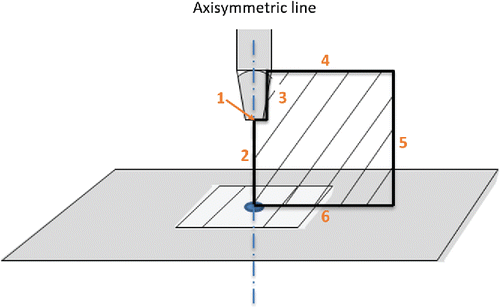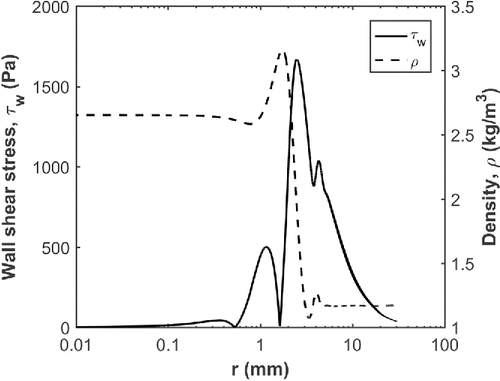ABSTRACT
Chemical, biological, radiological, and explosive incidents produce immediate as well as delayed hazards as a result of reaerosolization of deposited particles from surfaces. Understanding reaerosolization mechanisms is important for hazard prediction and mitigation processes. A method to efficiently reaerosolize 1–5 µm particles (approximately the size of bacterial spores) has not been previously available; therefore, this study was conducted to test a simple and effective method to reaerosolize such particles. In this work, a high-speed vertical impinging jet was used to reaerosolize 1–5 µm polystyrene latex microspheres from a substrate, and measured removal efficiencies were compared with the performed numerical predictions. Experiments were conducted to determine the effect of location, number of pulsed air jets, particle size, aerosol generation methodology (wet and dry), and relative humidity (RH) on the amount of reaerosolization. The experimental results agreed with the numerical predictions and demonstrated that maximal reaerosolization efficiency (∼90% in several cases) occurs at a few millimeters from the jet center. At the peak removal location, reaerosolization increased with increasing particle size and with increasing number of pulsed air jets. Dry deposited particles exhibited significantly higher reaerosolization compared to wet deposited particles. Equilibration of samples at low (20%) RH showed higher reaerosolization compared to the high RH conditions for dry deposited particles. This study demonstrates the effectiveness of using a single vertical impinging jet for localized reaerosolization of bacteria-sized particles from surfaces.
EDITOR:
Introduction
Chemical/biological/radiological and explosive (CBRNE) incidents produce immediate as well as delayed hazards to the general population. The delayed risk is a result of reaerosolization of deposited particles from surfaces, which has the potential to be hazardous to the population for many years. Understanding reaerosolization mechanisms is required for the development of hazard prediction and mitigation processes after an intended or an accidental release and deposition of CBRNE particles onto surfaces. Particles can be reaerosolized from outdoor surfaces because of wind, vibration due to vehicular movement, etc. In indoor environments, resuspension of particles is primarily driven by human activity (Qian and Ferro Citation2008). In addition to large-scale reaerosolization, aerosol resuspension from small-scale substrates is of importance in industries such as semiconductor processing, where air jets are used as a low-cost approach for cleaning surfaces containing contaminant particles. In all these situations, the fate of particles that are attached to a surface depends on the balance of forces acting on the particles.
The strength of particle attachment to substrates depends on particle physical properties (shape, size, material), surface properties (material, roughness, and contamination of the surface), duration of contact, relative humidity (RH), temperature, and initial contact velocity. The forces acting on a particle in contact with a surface include van der Waals forces, electrostatic forces, and capillary forces (Hinds Citation1999). Van der Waals forces are molecular forces that are a result of dipoles and complementary dipoles created by random movement of electrons, which causes attractive forces between particles and surfaces. These forces are proportional to particle diameter and inversely proportional to the square of the distance between the particle and the substrate. Electrostatic forces are also important for attachment of particles, particularly for dielectric particles and surfaces where charges do not migrate. Electrostatic forces are proportional to the number of charges on the particle and the surface and inversely proportional to distance squared. In the presence of an imposed electric field, the Coulomb force acting on a particle is proportional to the charges carried by the particle. The electrostatic image force, which is always attractive, is proportional to the square of particle charge and inverse-square of distance of particle from a conducting surface. Capillary forces can be significant in particle adhesion and are caused by the surface tension of the liquid drawn into the capillary space between the particle and surface. Capillary forces have been observed to exhibit much stronger adhesive properties for particles deposited from slurries compared to those of the same material but deposited by dry methods (Layshock et al. Citation2012).
The removal of particles residing on substrates requires overcoming the above listed adhesion forces. Studies have been conducted to evaluate the resuspension of inert, biological, and radiological particles in laboratories, wind tunnels, and in the field, and models have been developed to predict the resuspension using particle size, air velocity, time, particle type, particle diameter, density, surface features, and surface roughness as independent variables (Loosmore, Citation2003, among others). Many researchers have studied the mechanism of particle removal from surfaces and have suggested three primary mechanisms for particle reaerosolization: lift-off, sliding, and rolling. Among these mechanisms, rolling has been identified as the primary driver of detachment by forced air for nearly spherical particles (Hinds Citation1999; Soltani and Ahmadi Citation1994, Citation1999). For flow-driven resuspension, the critical parameters include particle diameter, drag force on the particles due to fluid flow, time, particle shape, adhesive forces, and roughness of the particle and surface (Loosmore Citation2003; Goldasteh et al. Citation2013b).
Numerous studies have been conducted in the past to determine the resuspension of particles from surfaces under the influence of airflow (Masuda et al. Citation1994; Smedley et al. Citation1999; Phares et al. Citation2000b; Fletcher et al. Citation2008; Keedy et al. Citation2012; EPA-Report Citation2014). In all of these studies, air jets were used to reaerosolize particles from surfaces in order to understand the relation between gas velocity, particle type, substrate properties, and resuspension efficiency. An impinging jet on a substrate results in a tangential flow with a thin boundary layer, which produces high shear stresses on the surface. The resultant near-wall shear flow acts to resuspend particles from the substrate when it overcomes the adhesion force binding the particles to the surface. Previous studies have used impinging jets oriented vertically, or at an angle, to a substrate to study resuspension of simple spherical particles (Phares et al. Citation2000b) and more complex explosive particles (Keedy et al. Citation2012) as well as bacterial spores (EPA-Report Citation2014).
Particles smaller than 5 μm, including single spore bacteria, are difficult to resuspend from substrates (Hinds Citation1999; Soltani and Ahmadi Citation1994, Citation1999). Because of this difficulty, experimental data on the resuspension of sub-5 μm particles is limited (Giess et al. Citation1997; Goldasteh et al. Citation2013a; Boor et al. Citation2013), and the efficiency of particles removed is often less than 10% of that deposited. Thus, the reported values of particle detachment fraction or resuspension rate for small particles is typically highly uncertain (EPA-Report Citation2014). This study was motivated by the need to develop a simple methodology to effectively reaerosolize a significant amount of deposited particles in the size range of single bacterial spores, which are smaller than 5 μm. Here, we present experimental and numerical analyses of particle removal using a high-speed vertical impinging jet. Experimental tests were conducted with simple spore surrogates: standard polystyrene latex (PSL) microspheres in the size range of 1–5 µm. The common usage of PSL particles for aerosol experiments and the similarity in their physical sizes to bacterial spores, make these particles ideal for the current tests. Particle removal characteristics as a function of aerosol generation method (wet or dry), distance from the jet center, number of jet pulses, and RH conditioning of the particles is reported. The experimental results are compared with the numerical predictions of particle removal characteristics obtained from computational fluid dynamics (CFD) simulations. The details of the CFD modeling, experimental setup, and experimental and CFD results are presented below.
Methods
In this study, the removal of PSL microspheres of 1, 3, and 5 µm diameter with a pulsed air jet from a vertically-aligned nozzle was determined experimentally and numerically. The particles were deposited on gridded glass slides and their removal efficiencies were measured using the experimental setup shown schematically in . The same setup was modeled computationally to predict the impinging jet flow field in the vicinity of the sample substrate and the resultant particle removal characteristics. The details of the experimental setup and CFD simulations are described in the following sections.
Experiments
Reaerosolization was determined as a function of particle size, particle distance from the center, and the number of sequential pulsed air jets. As some of the reaerosolized particles may redeposit back on the surface, this method may underestimate the percent reaerosolized. The dependence of particle wetness on reaerosolization was established using PSL microspheres deposited wet or dry and pre-exposed for 2 h to low (20%) or high (80%) RH conditions.
The substrate used in this study was Hemacytometer cover slides (Millennium Sciences, Inc., New York, NY, USA) with a 3 mm by 3 mm laser-etched grid as shown in . The smallest square size is 0.1 mm by 0.1 mm and the largest square size is 0.5 by 0.5 mm. The cover slides were cleaned by washing them with soap and water followed by isopropyl alcohol to remove particles and oils from surfaces. The cover slides were air dried before particle deposition. Experiments were conducted with dry or wet deposited particles on the gridded surface.
The wet fluorescent PSL particles were generated by aerosolizing the PSL particles in water using an Aeroneb nebulizer (Aerogen, Galway, Ireland) and then passing them into a 9” long cylinder with a diameter of 6”. The particles were then allowed to settle onto the gridded cover slides for use in experiments. The 1, 3, and 5 μm PSL particles were aerosolized for 1, 3.5, and 6 min, respectively, to produce the necessary number of particles for deposition onto the slides. The temperature and RH of the chamber were controlled at 90°F and 20 or 80% RH during the deposition.
The dry PSL particles were generated by aerosolizing a dilute solution of PSL microspheres in ethanol with a 120 kHz SonoTek aerosol generator (Sono-Tek Corporation, Milton, NY, USA). The particles were then passed into a 6” diameter and 24” long cylinder to settle onto the gridded cover slides. The use of ethanol and a longer settling tube ensured dry PSL microsphere deposition onto the surface. The use of a dilute solution allowed for the generation of droplets containing single PSL particles for this experiment. The chamber temperature and RH were controlled in the same manner as for the wet deposition.
The particles in each glass slide grid were manually counted using a microscope (Zeiss Axioskope, Carl Zeiss, New York, NY, USA) with an object lens of 100X. Both the visible and UV lights were utilized in counting the fluorescent PSL microspheres. A low level of visible light was used to observe the grids, and at the same time, the UV light of the microscope was employed for easy identification and counting of the fluorescent PSL microspheres. Manual counting allowed the operators to only count single microspheres and to not include clusters (doublets, triplets, etc.). As an example, the number of particles on a gridded slide used in our experiment ranged from 6 to 26 for 1 μm, 3 to 9 for 3 μm, and 2 to 5 for 5 μm particles in a 0.1 × 0.1 mm2 square area. A SEM picture of 1, 3, and 5 μm particles on a gridded slide is shown in .
The amount of reaerosolization of particles from surfaces may depend on the duration of pulse, pulse shape, and the deposition of reaerosolized particles. Earlier studies using air jets to reaerosolize particles from surfaces showed no significant change in reaerosolization with the duration of air pulse over a range of 25 to 100 ms; shorter pulses were shown to be preferable to reduce the dilution of suspended particles (Keedy et al. Citation2012). Since this present study counts particles on substrates rather than from airborne concentration measurements, a jet pulse duration of 560 ms was used. The characteristics of this jet pulse were determined using a custom-made strain gauge balance (3/8-inch string balance, custom fabricated by Modern Machine and Tool, Newport News, VA, USA). The ramp up time of the pulse was 0.14 s and the ramp down time was 0.008 s. The highest gauge pressure between the solenoid and the orifice was measured to be 358.5 kPa using a pressure gauge (Safecase Master Test Type 200-C, Marsh Instrument Company, Newell, WV, USA), and the maximum mass flow rate was measured at 331.11 SLPM (standard L/min) by a TSI Series 4000 flow meter (TSI Inc., Shoreview, MN, USA). During the experiment, a solenoid was used to deliver one pulsed air jet through an orifice (2.38 mm diameter) for each push of a button. Based on preliminary tests that resulted in significant reaerosolization, the distance between the orifice and the surface was chosen to be 1.5 cm; our study did not attempt to systematically optimize this distance. Other studies have evaluated the effect of distance between the surface and the orifice on reaerosolization. A study by Mei et al. (Citation2016) showed that there may be an optimal jet impingement height for high surface dust load conditions; for low dust conditions, they did not observe an optimum height, but they did observe more reaerosolization as the separation distance was reduced.
In our tests, the grid containing the PSL particles was placed directly below the jet, and sequential pulsed air jets were delivered to the substrate by pushing the button multiple times. Reaerosolization was then determined as a function of distance from the center of the jet. In this study, reaerosolization efficiency, with one or several pulsed air jets, was calculated by determining the number of particles remaining after a selected number of pulsed air jets (Cafter) to those present before exposure to the air jet (Cbefore) as:
Reaerosolization efficiency was determined after 1 pulsed air jet for all test conditions (N = 8 replicates) and after 1, 2, 5, 10, 25, 50, and 100 pulsed air jets for all wet deposited particles at 20% RH.
Experimental results
In the initial study, reaerosolization efficiency as a function of distance from the center for a single pulsed air jet was determined for wet deposited particles at room temperature and RH conditions. The results shown in demonstrate that the highest reaerosolization was at a location ∼1 mm from the center of the jet (maximum peak location). Mei et al. (Citation2016) also showed a region of high particle reaerosolization away from the center. In our results, reaerosolization increased with particle size; resuspension of 5 μm particles reached ∼90% at the peak location. All subsequent results were measured at this peak location.
Figure 2. Reaerosolization efficiency of PSL microspheres (1, 3, and 5 μm) as a function of distance from the center of the pulsed air jet.

Reaerosolization efficiency measured as a function of the number of pulsed air jets is shown in . For all particle sizes, reaerosolization efficiency increased with increasing number of pulsed air jets, consistent with observations by Otani et al. (Citation1995), and plateaued after ∼10 pulsed air jets. These results indicate that if a sufficient number of pulsed air jets (∼10) were used, a quasi-steady-state reaerosolization efficiency is obtained. On the other hand, a study by Masuda et al. (Citation1994) indicated that the removal characteristics of the sequential pulse jet were the same as those obtained by a one-pulse jet as long as the total duration of the air jet was kept constant. These results indicate that to study relative resuspension efficiencies as a function of particle size, experiments should ideally be conducted with the same number of pulsed air jets of the same duration. All subsequent results utilized a single pulsed air jet.
Figure 3. Reaerosolization efficiency of PSL microspheres (1, 3, and 5 µm diameter) from the substrate as a function of number of pulsed air jets, 1 mm away from the center.

The dependence of the initial hydration (wet or dry) state and environmental RH conditions (20% and 80%) for 2 h prior to the pulsed air jet on the reaerosolization efficiency is shown in . Statistical test results comparing the two aerosol generation methods and RH conditions as a function of particle size are provided in and summarized here.
Figure 4. Reaerosolization efficiency of PSL microspheres (1, 3, and 5 µm diameter) for various combinations of wet/dry deposition and 80%/20% RH, located 1 mm away from the center using a single pulsed air jet.
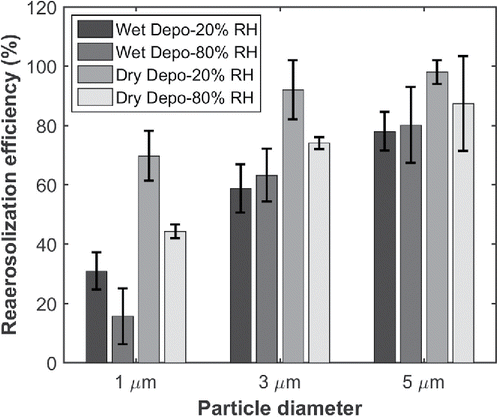
Table 1. Summary statistical t-test p-values of the data shown in .
As expected based on particle surface area per mass arguments, larger particles were more easily removed compared to smaller particles for the same particle deposition and RH conditions. In general, dry deposited particles reaerosolized more than the wet deposited particles for all particle sizes and RH conditions, as expected based on simple capillary force arguments. Significantly higher reaerosolization was observed for all three sizes for dry deposited particles compared to wet deposited particles at 20% RH condition (p < 4.9E-6); however, only 1 and 3 μm sizes showed statistically significant differences (p < 0.003) for dry vs. wet deposition at 80% RH condition. 5 μm particles had more than 77% reaerosolization at all conditions, and the weaker effects of RH and deposition method, compared to stronger particle size effects, may not have been observable because of such high reaerosolization. Statistically significant differences in humidity effect were observed with dry deposition for 1, 3, and 5 μm particles; however, only 1 μm particles showed statistically significant differences at 20% vs. 80% RH for wet deposited particles.
Discussion of experimental results
In an earlier study (EPA-Report Citation2014), an airflow jet directed at an angle was used to reaerosolize Bacillus anthracis-Ames (Ba-Ames) spores and simulants from various surfaces under different environmental conditions. In that study, the reaerosolization efficiency of the spores (∼1 μm diameter) was low (<2%) for all conditions. In comparison, the current study achieved a much higher reaerosolization efficiency (16–70%) using similarly sized PSL particles (1 μm). While the adhesion properties of the two particles may not be the same, the results still suggest that using a vertical jet may be beneficial in bacterial spore particle resuspension studies. Also, in the EPA study, it was shown that wet deposited Ba-Ames spores reaerosolized 81% lower than dry deposited Ba-Ames spores. These results are also consistent with the results of Fletcher et al. (Citation2008) who found that wet deposited fluorescent polystyrene microsphere particles were harder to reaerosolize compared to dry deposited particles. Our measurements also show lower reaerosolization for wet deposited PSL particles for all sizes and are thus consistent with these past observations. This could be due to more effective formation of the liquid meniscus with wet deposition, thus promoting much stronger capillary forces.
In our study, for all dry deposited particles and 1 μm wet deposited particles, the resuspension efficiency was affected by the RH of the environment. It is possible that the wet deposited 3 and 5 μm particles were not affected by RH conditions, since the liquid meniscus may have already formed. Additional experiments will be required to understand the dependence of resuspension efficiency on RH exposure time and particle size.
CFD modeling
The particle removal characteristics from a substrate depend strongly on the nature of the boundary layer flow over its surface. The boundary layer flow over a substrate with a vertical impinging flow jet was studied theoretically by Phares et al. (Citation2000a,b). Their analysis of boundary layer characteristics assumed steady, incompressible, and laminar flow. In the current experiments, to enable efficient removal of 1 µm particles, the substrate is placed close to the jet nozzle that is operated at sonic condition with a high stagnation pressure. Under such conditions, the compressible, turbulent, under-expanded nature of the flow must be considered (Adamson and Nicholls Citation1959; Donaldson and Snedeker Citation1971). In addition, pulsed jet flow results in unsteady flow over the substrate, and its effect on particle resuspension must be modeled. However, as observed in , for a given particle size, about 70% to 80% of the particles resuspended after repeated pulsing were removed after the first pulse, with almost no change in reaerosolization efficiency after five to ten pulses. As the reaerosolization efficiency after the first pulse is comparable to the steady-state value, the pulsed-jet particle removal problem can be studied using the steady-state flow simulation.
Numerical simulations were performed using the commercial computational fluid dynamics (CFD) software ANSYS-FLUENT (ANSYS Inc.; Version 14.5). Li et al. (2004) showed that the FLUENT code is capable of resolving high pressure free jet flows. The experimental setup shown in was modeled assuming axi-symmetry geometry. The schematic diagram of the computational domain is shown in , and the details of the geometry of the domain and the boundary conditions are listed in .
Table 2. Details of computational domain and boundary conditions. (The listed boundary numbers correspond to those shown in .)
The CFD simulations were conducted for compressible, turbulent flows. The k-ϵ turbulence model with enhanced-wall treatment was used for evaluating the flow field, turbulence properties, and the wall shear stress on the surface. Earlier, Post et al. (Citation2000) used a similar approach for studying jet entrainment flows. The CFD simulations were conducted assuming steady-state compressible jet flows with a mass flow rate of . As the flow is choked at the nozzle throat, the static pressure is evaluated according to the sonic condition at the exit of the nozzle,
(absolute).
A dense quadrilateral computational mesh was generated for these simulations, with a high concentration of grids near the exit of the nozzle and in the boundary layer region near the substrate. The mesh cell sizes in the vicinity of the inlet (boundary no. 1) and the jet centerline had areas of about 88 μm2 and 0.4 mm2, respectively. To accurately capture the viscous sublayer deep inside the turbulent boundary layer profile, the first grid over the substrate was selected to be at a height of 5 μm. With the variation of air density, the maximum value of first grid y+ is about 8 with the local average of about 6.6 over the peak region of shear velocity. The typical value of first grid y+ is less than 5. Here y+ = yν/u* is the ratio of the vertical distance from the boundary to the viscous length scale, u* is the shear velocity and ν is the gas kinematic viscosity. The selection of small values of y+ ensures sufficiently high mesh density for accurately capturing the details of the viscous sublayer near the substrate.
The CFD simulations were run until the residuals over the domain reached less than 10−3 for continuity, energy equations, and axial velocity, less than 10−2 for radial velocity and less than 10−5 for k and ϵ equations. Grid convergence was checked by doubling the number of meshes in the area between the nozzle and the surface and tracking the corresponding shear velocity on the surface. Mesh refinement was continued until the CFD results for the peak shear velocity remained largely unchanged (less than 2% change) with doubling the mesh density.
CFD results
For a mass flow rate of 0.0061 kg/s at the inlet, the CFD results for the static pressure and Mach number contours are shown, respectively, in and . It is seen that the flow at the nozzle exit is sonic (Mach = 1) and the flow downstream of the nozzle is under-expanded, with a normal shock at a short distance from the nozzle exit. Further downstream, several compression and expansion waves are seen within the jet boundary (), with intercepting shocks that form diamond shape structures, similar to those observed in under-expanded high-pressure compressible jet flows reported by Adamson and Nichollas (Citation1959) and Franquet et al. (Citation2015).
Figure 6. Compressible jet flow with inlet mass flow rate of 0.0061 kg/s. (a) Static pressure (absolute) contours. (b) Mach number contours.
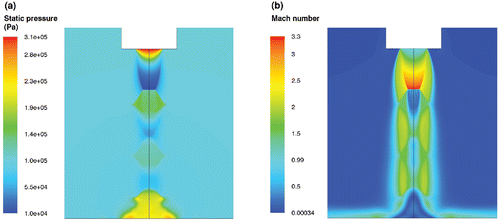
As compressible flow impinges on the substrate, a recirculation region with a velocity deficient core, also referred to as the stagnation bubble, forms (Phares et al. Citation2000a). The tangential flow then expands radially outward. The corresponding wall shear stress profile as a function of radial distance is shown in . Also shown in this figure, is the gas density variation along the substrate. It is seen that the shear stress has a large peak at a distance of about 2.5 mm from the centerline. There is also a smaller secondary peak in the recirculation region at a radius of about 1 mm where the flow has an inward direction toward the centerline. The shear stress is zero at a distance of about 1.8 mm, which is the point of reattachment of the stagnation bubble. also shows that the density is quite high in the stagnation bubble region and reaches a peak value at a distance of about 1.8 mm, which is the reattachment point.
The distribution of shear velocity () is evaluated from the wall shear stress,
, and gas density,
. The shear velocity is a critical parameter for determining whether particles remain on the substrate or are resuspended. A comparison of the calculated shear velocity with the critical shear velocity required to remove particles from substrates determines the expected region from which particles will be reaerosolized.
For the removal of spherical particles from smooth surfaces, the theoretical critical shear velocities were calculated as (Soltani and Ahmadi Citation1994),[1] where
is the critical shear velocity for detachment of particles of diameter, d. Here WA is the thermodynamic work of adhesion, given as,
, where
is the separation distance
, K is the composite Young's modulus defined as,
, where ν1,2 and E1,2 are the Poisson ratio and Young's modulus of the particle and the substrate, respectively,
is the gas density,
is the Cunningham slip correction coefficient, and μ is the gas dynamic viscosity. Note that Equation (Equation1
[1] ) was derived using the JKR adhesion theory, and nonlinear drag is implicit and must be solved iteratively. Also here the effect of gravity for micron size particles, which is negligibly small, was neglected. Using the values of particle and substrate physical properties reported in the literature as summarized in , the critical shear velocities for removal of 1, 3, and 5 µm PSL particles from glass substrates as predicted by Equation (Equation1
[1] ) are listed in .
Table 3. Particle-substrate parameters used in predicting critical shear velocities of particle removal.
Table 4. Critical shear velocities for PSL particles of different sizes calculated with smooth and rough surface assumptions for WA of 0.0122 and 0.0650 J/m2.
The CFD-calculated shear velocity as a function of distance from the centerline is shown in . It is seen that the maximum shear velocity of about 34 m/s is at a distance of about 3 mm from the centerline. There is also a secondary peak of 13.5 m/s in the recirculation region at a distance of about 1 mm. The gas density in the recirculation region is higher aiding enhanced removal of particles from this region. Also shown in are the critical shear velocity values for the removal of 1, 3 and 5 µm particles as calculated from Equation (Equation1[1] ), for different particle-surface adhesion properties (work of adhesion, WA, values of 0.0122 and 0.065 J/m2). The results suggest that particles should be removed over a narrow region away from the center, with the removal region narrowing with decreasing particle size. The uncertainty in the values of particle-surface adhesion properties results in uncertainty in the prediction of the spatial extent of particle removal from the substrate. The numerical results, however, suggest that using an impinging jet setup should allow for removal of particles as small as 1 μm from glass substrates at certain radial distance from the jet centerline.
Figure 8. Distribution of shear velocity along the substrate as a function of radial distance from the centerline (steady-state result). Also shown are critical shear velocities, , for 1, 3, 5 µm particles for two substrate-particle properties (work of Adhesion values of WA = 0.0122 and 0.065 J/m2) assuming smooth surface.
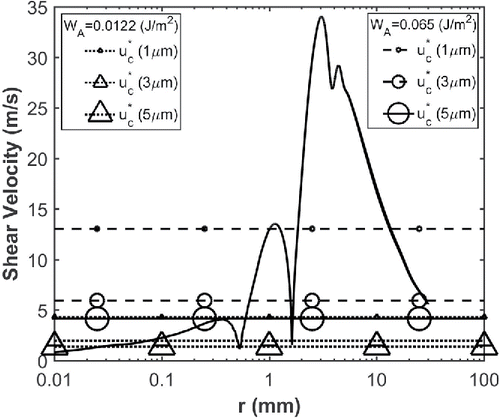
The CFD simulations predict a maximum shear velocity at ∼3 mm and a local peak at ∼1 mm within the stagnation bubble. The location of maximum shear velocity within the stagnation bubble is comparable with the location of experimentally observed maximum reaerosolization efficiency (∼1 mm; ). A high rate of removal in the high shear velocity region outside the stagnation bubble, however, was not observed in the experiment.
The spatial extent of particle removal predicted by the CFD simulation is compared with the experimental data in . For this comparison, the numerical particle removal is determined as the width of the removal region with shear velocity greater than the critical shear velocity. For the experimental data, the extent of particle removal is estimated as the width of the radial region with reaerosolization efficiency greater than 30%. The trend of increasing removal extent with increasing particle size is seen in both the numerical simulations and experimental results. The numerical simulations are, however, seen to over-predict removal extent compared to the experimental data. This discrepancy in the extent of particle removal could be due to several factors, including: (1) the experiments were conducted with a jet pulse for a short instant of time while the modeling results assumed steady compressible flow, ignoring the unsteady and short duration of the pulsed air jet; (2) the numerical calculations of particle removal locations are based on critical shear velocities for steady-state particle detachment, while the short duration of the experiments requires consideration of instantaneous removal rates, which are not known; (3) the particle and surface properties used in the calculation of critical shear velocities are based on the values reported in the literature that may not be identical to those for the materials used in the experiment; and (4) use of constant gas properties (pressure and temperature) for calculation of critical shear velocities in and . Temperature and pressure variations affect gas properties and consequently the critical shear velocity for particle removal. Consideration of these additional refinements, however, is left for future studies.
Figure 9. Comparison of the radial extent of particle removal as predicted by the steady-state CFD simulation with the experimental data.
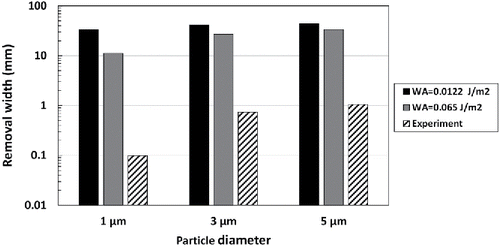
To determine if the unsteady nature of flow explains some of the experimental observations on the extent of particle removal, we performed a preliminary unsteady CFD simulation by considering a time-varying upstream pressure pulse profile for 200 ms. The unsteady compressible CFD simulations were conducted with the total pressure upstream of the inlet, P0, increasing linearly from 101 to 586 kPa (absolute) over 140 ms and then maintained at a constant value for the rest of simulation. Here, the stagnation pressure of 586 kPa (absolute) corresponded to a maximum flow rate of 0.0061 kg/s for choked flow condition at the nozzle.
The maximum shear velocity calculated as a function of time for the unsteady simulations is shown in . The maximum shear velocity increased over time from 12.4 m/s at 5 ms to 33 m/s at 140 ms, and remained constant after that. The unsteady CFD simulation predicts the formation of the stagnation bubble after about 85 ms and an increase in size of the bubble over time until the inlet pressure reaches its maximum value. The shear velocity profile at the end of unsteady CFD calculations, which corresponds to the maximum inlet stagnation pressure, is seen to be close to the steady-state CFD results ().
Figure 10. Maximum shear velocity and corresponding radial location as function of time for unsteady CFD simulation.
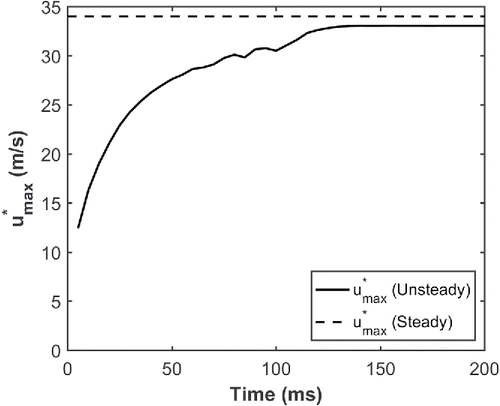
The preliminary unsteady simulation results suggest that the maximum shear velocity is nearly matched with the steady-state value within the pulsing duration of the jet. The spatial distribution of the shear velocities obtained at the end of the unsteady simulations (not shown) also matched the steady-state results. These preliminary unsteady simulations are, thus, unable to explain the discrepancy between the predicted spatial extent of particle removal and the experimental observations. This suggests that the time-dependent particle detachment behavior as was observed in the earlier studies of Braaten et al. (Citation1990) and Wu et al. (Citation1992) may be important and must be considered for accurate modeling of unsteady particle detachment with pulsed jets. There are, however, no existing models that capture the time-dependent behavior of particle detachment. In addition, relative humidity (RH) and particle charge will act to enhance particle attachment onto surfaces and these effects are not considered in the present model. Also, stochastic nature of particle resuspension (Goldasteh et al. Citation2013b, Citation2015) may be important and need to be included in the modeling study.
Conclusions
This study was conducted to develop and test a methodology for effective resuspension of bacteria and/or other 1–5 μm particles from surfaces. A vertical impinging jet was utilized to reaerosolize 1, 3, and 5 μm wet or dry deposited PSL microspheres conditioned at 20% or 80% RH conditions for 2 h. Experimental results suggest that the reaerosolization efficiencies are a function of particle size, location relative to the jet, deposition method, and the RH conditioning of particles and substrates. In particular, reaerosolization was seen to increase with particle size, and maximal efficiency was observed at about 1 mm off-center from the jet. Dry deposited particles also had significantly higher reaerosolization compared to wet deposited particles. Higher reaerosolization occurred at lower RH conditions for dry deposited particles. These results indicate that aerosol generation/deposition (wet or dry) method and RH conditions need to be controlled to obtain accurate and reproducible results.
CFD simulations considering steady and unsteady, compressible, turbulent flow conditions were conducted to capture the flow field characteristics in the vicinity of the substrate. Using a high resolution mesh, shear velocities were determined as a function of radial location and time. Comparing the numerically obtained shear velocities with the critical values required for particle removal, the region over which particles are removed was predicted. The numerical results for the location of maximum shear velocity within the stagnation bubble were seen to be largely in agreement with peak removal location of the experimental observations. However, the predicted spatial extent of particle removal was much larger than that observed experimentally, suggesting the possible importance of time-dependent particle detachment characteristics and potential importance of RH and particle charge in particle-substrate interactions.
Acknowledgments
The authors would like to thank Dr. Jerold Bottiger and Daniel Wise for their assistance with the experimental setup and some of the measurements.
Funding
This research was funded by the Edgewood Chemical Biological Center, Surface Science Initiative. SD, BN, and GA would like to thank the Defense Threat Reduction Agency for funding support (contract number: HDTRA1-14-C-0009).
References
- Adamson, T. C., and Nicholls, J. A. (1959). On the Structure of Jets From Highly Underexpanded Nozzles Into Still Air. J. Aerospace Sci., 26:16–24.
- Boor, B. E., Siegel, J. A., and Novoselac, A. (2013). Wind Tunnel Study on Aerodynamic Particle Resuspension from Monolayer and Multilayer Deposits on Linoleum Flooring and Galvanized Sheet Metal. Aerosol Sci. Technol., 47:848–857.
- Braaten, D. A., Paw, U. K. T., and Shaw, R. H. (1990). Particle Resuspension in a Turbulent Boundary Layer-Observed and Modeled. J. Aerosol Sci.,1:613–628.
- Donaldson, C. D., and Snedeker, R. S. (1971). A Study of Free Jet Impingement. Part 1. Mean Properties of Free and Impinging Jets. J. Fluid Mech., 45(2):281–319.
- EPA-Report. (2014). Determination of the Difference in Reaerosolization of Spores Off Outdoor Materials, United States Environmental Protection Agency, Research Triangle Park, NC. pp. 1–45.
- Fletcher, R., Briggs, N., Ferguson, E., and Gillen, G. (2008). Measurement of Air Jet Removal Efficiencies of Spherical Particles from Cloth and Planar Surfaces. Aerosol Sci. Technol., 42:1052–1061.
- Franquet, E., Perrier, V., Gibout, S., and Bruel, P. (2015). Free Underexpanded Jets in a Quiescent Medium: A Review. Progr. Aerospace Sci., 77:25–53.
- Giess, P., Goddard, A. J. H., and Shaw, G. (1997). Factors Affecting Particle Resuspension from Grass Swards. J. Aerosol Sci., 28:1331–1349.
- Goldasteh, I., Ahmadi, G., and Ferro, A. R. (2013a). Wind Tunnel Study and Numerical Simulation of Dust Particle Resuspension from Indoor Surfaces in Turbulent Flows. J. Adhes. Sci. Technol., 27(14):1563–1579.
- Goldasteh, I., Ahmadi, G., and Ferro, A. R. (2013b). Monte Carlo Simulation of Micron Size Spherical Particle Removal and Resuspension from Substrate Under Fluid Flows. J. Aerosol Sci., 66:62–71.
- Goldasteh, I., Ahmadi, G., and Ferro, A. R. (2015). Particle Detachment from Rough Surfaces in Turbulent Flows: An Analytical Expression for Resuspension Fraction. Particul. Sci. Technol., 33(5):539–545.
- Hinds, W. C. (1999). Aerosol Technology: Properties, Behavior, and Measurement of Airborne Particles. John Wiley & Sons, Inc., New York.
- Ibrahim, A. H., Dunn, P. F., and Brach, R. M. (2003). Microparticle Detachment From Surfaces Exposed to Turbulent Air Flow: Controlled Experiments and Modeling. J. Aerosol Sci., 34(6), 765–782.
- Keedy, R., Dengler, E., Ariessohn, P., Novosselov, I., and Aliseda, A. (2012). Removal Rates of Explosive Particles from a Surface by Impingement of a Gas Jet. Aerosol Sci. Technol., 46:148–155.
- Layshock, J. A., Pearson, B., Crockett, K., Brown, M. J., Cuyk, S. V., Daniel, W. B., and Omberg, K. M. (2012). Reaerosolization of Bacillus spp. in Outdoor Environments: A Review of the Experimental Literature. Biosecur. Bioterror., 10:299–303.
- Loosmore, G. A. (2003). Evaluation and Development of Models for Resuspension of Aerosols at Short Times After Deposition. Atmos. Environ., 37:639–647.
- Masuda, H., Gotoh, K., Fukada, H., and Banba, Y. (1994). The Removal of Particles from Flat Surfaces Using a High-Speed Air Jet. Adv. Powder Technol., 5:205–217.
- Mei, X., Zhang, T., and Wang, S. (2016). Experimental Investigation of Jet-Induced Resuspension of Indoor Deposited Particles. Aerosol Sci. Technol., 50:230–241.
- Nicholson, K. W. (1988). A Review of Particle Resuspension. Atmos. Environ., 22:2639–2651.
- Otani, Y., Namiki, N., and Emi, H. (1995). Removal of Fine Particles from Smooth Flat Surfaces by Consecutive Pulse Air Jets. Aerosol Sci. Technol., 23:665–673.
- Phares, D. J., Smedley, G. T., and Flagan, R. C. (2000a). The Inviscid Impingement of a Jet with Arbitrary Velocity Profile. Phys. Fluid., 12:2046.
- Phares, D. J., Smedley, G. T., and Flagan, R. C. (2000b). The Wall Shear Stress Produced by the Normal Impingement of a Jet on a Flat Surface. J. Fluid Mech., 418:351–375.
- Post, S., Iyer, V., and Abraham, J. (2000). A Study of Near-Field Entrainment in Gas Jets and Sprays Under Diesel Conditions. J. Fluid. Eng., 122:385.
- Qian, J., and Ferro, A. R. (2008). Resuspension of Dust Particles in a Chamber and Associated Environmental Factors. Aerosol Sci. Technol., 42:566–578.
- Smedley, G. T., Phares, D. J., and Flagan, R. C. (1999). Entrainment of Fine Particles from Surfaces by Gas Jets Impinging at Normal Incidence. Exp. Fluid., 26:324–334.
- Soltani, M., and Ahmadi, G. (1994). On Particle Adhesion and Removal Mechanisms in Turbulent Flows. J. Adhes. Sci. Technol., 8:763–785.
- Soltani, M., and Ahmadi, G. (1999). Detachment of Rough Particles with Electrostatic Attraction From Surfaces in Turbulent Flows. J. Adhesion Sci. Technol., 13:325–355.
- Tsai, C.-J., Pui, D. Y. H., and Liu, B. Y. H. (1991). Elastic Flattening and Particle Adhesion. Aerosol Sci. Technol., 15:239–255.
- Wu, Y.-L., Davidson, C. I., and Russell, A.G. (1992). Controlled Wind Tunnel Experiments for Particle Bounce off and Resuspension. Aerosol Sci. Technol., 17:245–262.


